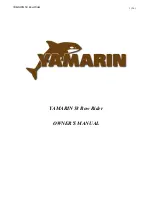
Nev
er disarm a CO
detector. If a CO detector alar
ms,
immediately ventilate the area and chec
k passengers for
symptoms of CO intoxication. See y
our Larson dealer for
assistance in diagnosing the cause of the alarm.
Navigational Aids Chart
The illustrated Na
vigational Aids Chart on page 1.15
contains infor
mation concerning whistle signals
, storm
war
nings, br
idge signals and buo
y description and inf
ormation.
Running Aground
If your boat r
uns aground, first chec
k persons aboard for
injury. Then chec
k for an
y damage to the boat or propeller(s).
Watch the temper
ature gauge to make sure y
ou do not over-
heat the engine while running in the shallo
w water
. If the boat
is not taking on any w
ater, it ma
y be possible to heel the boat
by shifting the w
eight of passengers and/or gear and raising
the stern dr
ive while re
versing the engine
.
Collision
If a serious collision occurs y
ou should first check the con-
dition of all passengers aboard, then inspect your boat to
determine the e
xtent of damage.
1.
If your boat has a ship-to-shore r
adio, contact (VHF
Channel 16 or CB Channel 22) the U.S
. Coast Guard
or other rescue authorities immediately
.
2.
Prepare to assist the other craft unless y
our passen-
gers and/or boat are in danger.
3.
If the bow of the other boat penetr
ated your boat’
s
hull, prepare to bloc
k the opening once the boats are
separated.
4.
Shore up the hole with a spare PFD or bunk cushion
from your boat.
5.
While bloc
king the hole, tr
im weight of the boat (where
hole exists) so that it is out of the w
ater during repairs
.
6.
If the extent of damage places y
our boat in a possible
sinking condition have all persons aboard put on their
PFD (personal flotation devices).
Fire
A fire on board your boat is a ser
ious emergency , y
ou must
wor
k quickly to implement saf
ety procedures. If a fire
occurs, immediately stop the engine
.
1.
Prompt all persons aboard to put on their PFD (person-
al flotation device).
2.
If the fire is small, attempt to put it out with your fire
extinguisher
. If the fire is in the engine compartment,
turn off the bilge b
low
er.
Do notopen the engine com-
1.16
WARNING:
CO detectors should be marine g
rade
and professionally installed and calibr
ated. Failure to
do so may result in improper functioning and f
alse
reading.
WARNING:
Do notuse dec
k hardware f
or towing.
Larson Boats recommends that you use a commercial
towing ser
vice if your boat becomes g
rounded.
Never disarm a CO detector. If a CO detector alarms,
immediately ventilate the area and check passengers for
symptoms of CO intoxication. See your Larson dealer for
assistance in diagnosing the cause of the alarm.
Navigational Aids Chart
The illustrated Navigational Aids Chart on page 1.15
contains information concerning whistle signals, storm
warnings, bridge signals and buoy description and information.
Running Aground
If your boat runs aground, first check persons aboard for
injury. Then check for any damage to the boat or propeller(s).
Watch the temperature gauge to make sure you do not over-
heat the engine while running in the shallow water. If the boat
is not taking on any water, it may be possible to heel the boat
by shifting the weight of passengers and/or gear and raising
the stern drive while reversing the engine.
Collision
If a serious collision occurs you should first check the con-
dition of all passengers aboard, then inspect your boat to
determine the extent of damage.
1. If your boat has a ship-to-shore radio, contact (VHF
Channel 16 or CB Channel 22) the U.S. Coast Guard
or other rescue authorities immediately.
2. Prepare to assist the other craft unless your passen-
gers and/or boat are in danger.
3. If the bow of the other boat penetrated your boat’s
hull, prepare to block the opening once the boats are
separated.
4. Shore up the hole with a spare PFD or bunk cushion
from your boat.
5. While blocking the hole, trim weight of the boat (where
hole exists) so that it is out of the water during repairs.
6. If the extent of damage places your boat in a possible
sinking condition have all persons aboard put on their
PFD (personal flotation devices).
Fire
A fire on board your boat is a serious emergency, you must
work quickly to implement safety procedures. If a fire
occurs, immediately stop the engine.
1. Prompt all persons aboard to put on their PFD (person-
al flotation device).
2. If the fire is small, attempt to put it out with your fire
extinguisher. If the fire is in the engine compartment,
turn off the bilge blower. Do not open the engine com-
1.16
WARNING:
CO detectors should be marine grade
and professionally installed and calibrated. Failure to
do so may result in improper functioning and false
reading.
WARNING:
Do not use deck hardware for towing.
Larson Boats recommends that you use a commercial
towing service if your boat becomes grounded.
















































